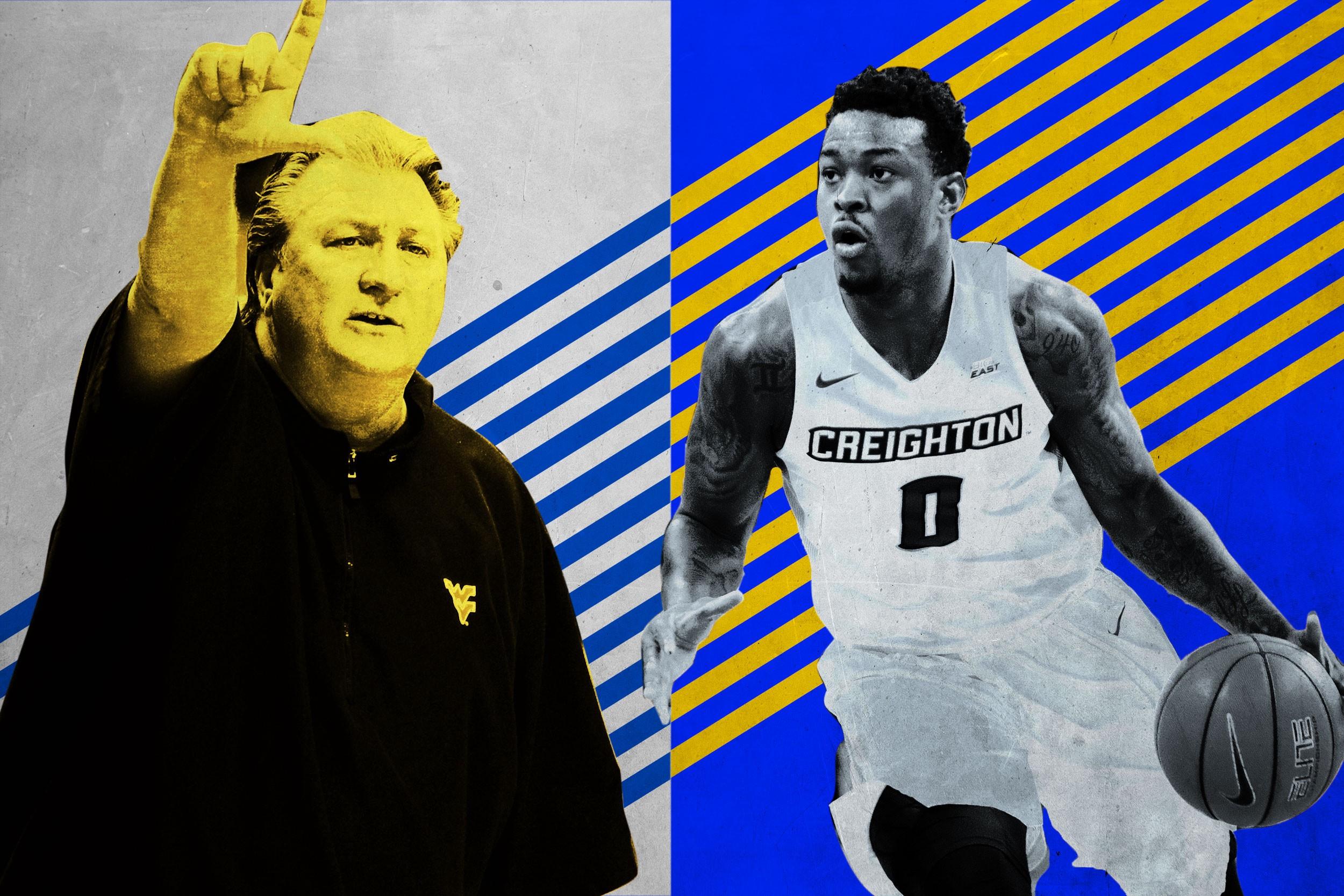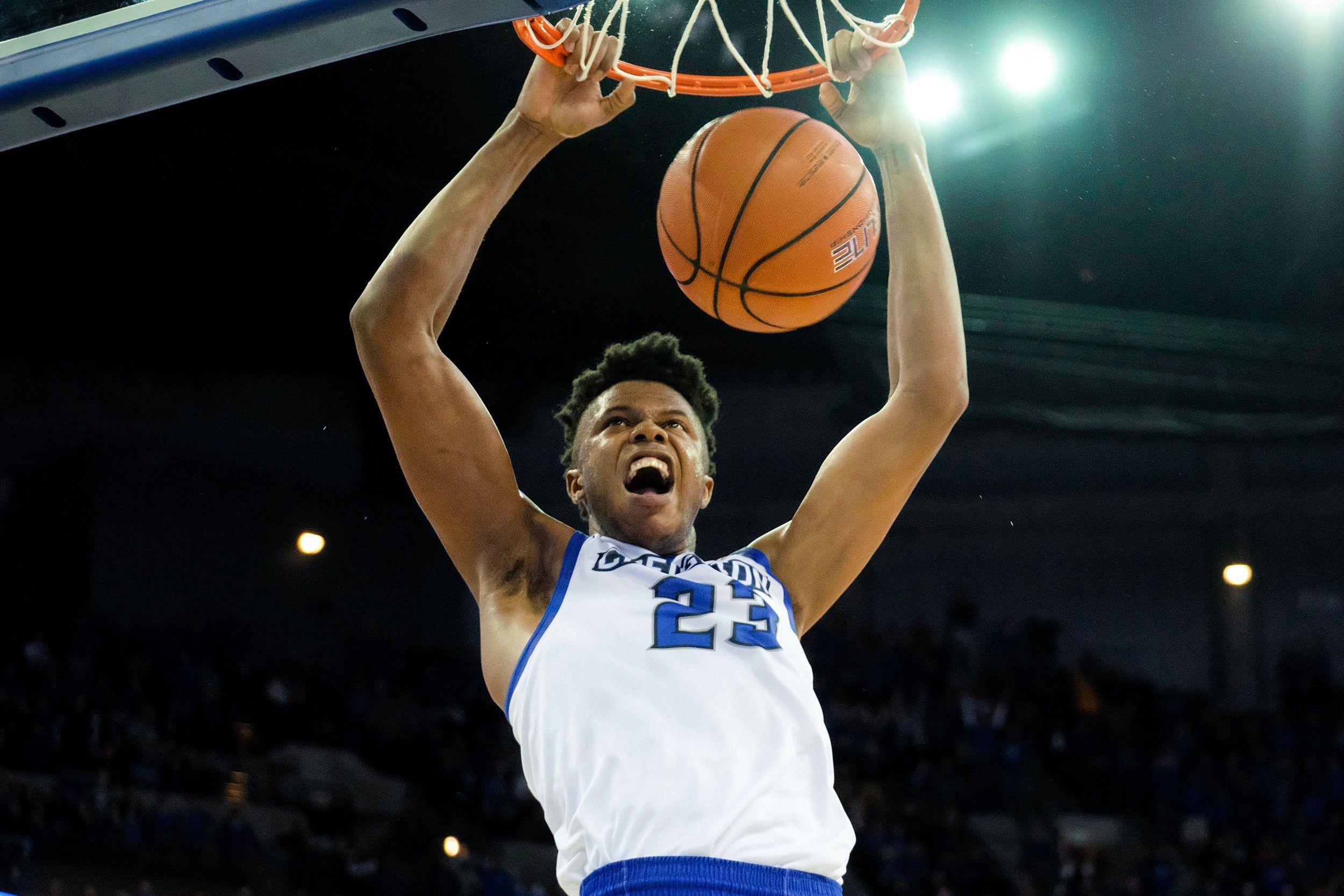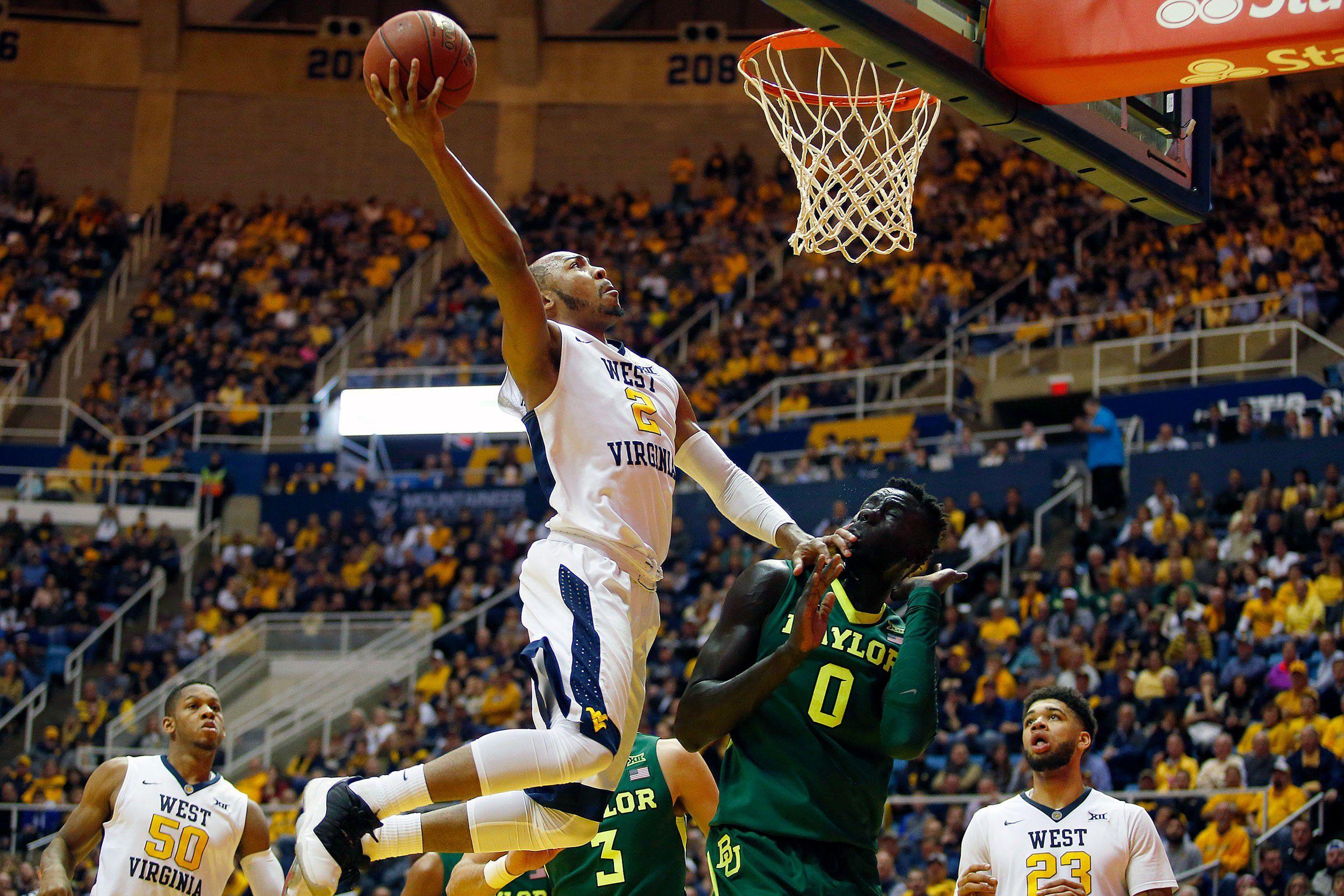West Virginia’s Press Is the Stuff of Nightmares
The Mountaineers demolished the top-ranked team in the nation. Is their formula for success built for March? Plus, Creighton showed that it can do more than just shoot teams into oblivion.
As is usually the case, traditional powers are dominating the college basketball headlines this season, for a number of reasons: They’re putting on wildly entertaining games, blowing out ranked opponents, showcasing national player of the year candidates, and getting upset by terrible teams. That, and Grayson Allen continues to be Grayson Allen.
To help shift the focus, the most powerful power rankings in college basketball will do its part to give a little shine to two teams — Creighton and West Virginia — that are kinda, sorta flying under the radar. On the surface, these two couldn’t be more different. Creighton has one of the best offenses in the country and tends to look disinterested on defense, while West Virginia has one of the best defenses in the country and tends to look like it’s playing a completely different sport when it runs a half-court offense. But there are some similarities: Both like to play fast, both are coming off of blowout wins over highly ranked opponents, and both are coached by guys who look like former offensive linemen.
Let’s get to it.
12. Arizona (16–2)
11. Louisville (14–3)
10. Oregon (15–2)
9. Creighton (16–1)
Full disclosure: I purposely hadn’t written anything about Creighton until this point because I’d been waiting for the Bluejays to play themselves out of relevancy. Don’t get me wrong — this team is a ton of fun to watch. Creighton’s offense can be jaw-dropping when it gets in a groove, and Mo Watson (who leads college basketball in assists per game), Marcus Foster, Justin Patton, and Khyri Thomas comprise a top four as good as any in America. But how often do the teams that are the most fun make deep NCAA tournament runs? How many teams have reached the Final Four in the past decade behind a mediocre defense and a fast-paced offense that relies heavily on jump shots? And haven’t we been here before with Creighton, where the Bluejays are must-see TV in January and February but you wouldn’t bet a nickel on them to do anything in March? Here’s a clip to jog your memory on just how fun some recent Creighton teams were.
Something interesting happened Wednesday night against Butler, though: Creighton played phenomenal defense for about 80 percent of the game. Sure, it had plenty of lapses (especially in the second half, when it was up big and then let its foot off the gas), and what should have been a 30-point Bluejays win turned into a 75–64 victory. But I saw enough to believe that this Creighton team, whose no. 8 ranking in the AP poll is the highest in program history, can supply the goods on defense when required. If you’re looking for something to distinguish this squad from those of the Doug McDermott era, that’s where you start.
No offense to McDermott, Ethan Wragge, and Grant Gibbs, but Creighton now has legitimately great athletes who have it in them to get after it on defense. Most of the time they’d just rather subscribe to the theory that the best defense is a good offense. And that’s OK, too. I should clarify that I don’t think teams have to play defense like 2014–15 Kentucky to maintain a shot at making the Final Four. I just need to see some sort of desire. I need to know that when things go south offensively — and at some point they always do — they can still find ways to win. I’d prefer to see Creighton use a more balanced approach, but at least these Bluejays aren’t as one-dimensional as they’ve been in the past.

By the way, I’m workshopping a new philosophy after watching Creighton shoot 55.4 percent from the field against Butler to extend its lead over UCLA as the nation’s best shooting team (53.8 percent on the season). Here’s my thought: In an optimal situation, over the course of an entire campaign no individual player should ever shoot better than, say, 60 percent from the field and/or 45 percent from 3. For example, Patton, the Bluejays’ stud freshman 7-footer, is currently shooting 74.6 percent from the field and 55.6 percent from deep. Which is great, but since he’s obviously such a great shooter, why aren’t his teammates getting him more shots? How is he fourth on the roster in field goal attempts? If it’s up to me, Patton is getting the green light to shoot every time he touches the ball until his percentage dips below 60. I mean, isn’t scoring the entire point of offense? So why bother setting screens and passing the ball around when you can just give the rock to a man who is putting it in the basket on nearly three-quarters of his tries, even when he’s fading away as the shot clock winds down?
I know this philosophy is half-baked. I’m just such a firm believer in feeding the man with the hot hand that I honestly want my epitaph to read, “He always fed the man with the hot hand.” I guess this strategy could become problematic for Creighton, whose entire roster seems to be in a perpetual state of what we in the business like to call “on fire.” But I think I’m on to something here. Stat nerds: Prove me wrong.
8. Baylor (15–1)
7. Florida State (16–1)
Halftime
It’s halftime, which can mean only one thing: It’s time for Dick’s Degrees of Separation, the most mildly amusing internet game involving college basketball! You know the drill: I give you the endpoint of a Dick Vitale tangent and you pick the path he took to get there. Let’s get to it.
During the Florida-Tennessee game last Saturday, how did Dick Vitale end up talking about Jameis Winston?
A. Immediately after Vitale comments that both Tennessee and Florida have deep benches, four new players check into the game. One is the Gators’ Canyon Barry, the son of NBA Hall of Famer Rick Barry. Vitale’s broadcast partner, Tom Hart, points out that the game is taking place on Canyon Barry’s 23rd birthday, which prompts Dickie V. to mention that his daughter’s birthday was the day before. He then comments that his daughter shares a birthday with both Lou Holtz and Jameis Winston.
B. A camera cuts to Tennessee coach Rick Barnes, prompting Vitale to talk about Barnes’s career, and how he worked at Texas for 17 seasons before coming to Tennessee, and Clemson for four seasons before heading to Texas. Hart asks Vitale if he thinks Barnes will cheer for Clemson in the upcoming college football national title game, to which Vitale replies that Clemson is going to need all the help it can get. Dickie V. says he believes Alabama will win rather easily, but admits that the Tigers will have a chance to pull off the upset if Deshaun Watson can play like Jameis Winston.
C. During a lull in the action, Hart asks Vitale if he thinks Florida is good enough to challenge Kentucky in the SEC. Dickie V. makes it clear that he believes the Wildcats are the heavy favorites, but that the Gators have a decent shot because their only losses this season have come against three great teams: Gonzaga, Duke, and Florida State. Hart points out how strange it is to hear Florida State mentioned as a great team, a remark that causes Vitale to explain to viewers just how good the Seminoles are. Vitale then mentions that FSU’s basketball success must be making “my buddy down in Tampa, Jameis Winston” very happy.
6. West Virginia (14–2)
Do you know how to talk to your kids about West Virginia’s defense? If not, it’s probably something you should figure out. The last thing you want is your unsuspecting 8-year-old stumbling across a Mountaineers game and being forever traumatized by what he sees. (But enough about Bob Huggins’s fashion, folks!)
I’m not sure I’m joking about this, by the way. I’ll never forget the first time I ran into a relentless full-court press during my playing career. I grew up in a rural Indianapolis suburb, which is another way of saying I was taught a very specific brand of basketball in my youth, along with every other kid in my area. I played against presses every so often, yet they were always one of two varieties: a 2–2–1 or a diamond 1–2–1–1 that could be beaten by even the most basic press-breaking concepts. But then I got older, joined an AAU team, and quickly learned that other styles of basketball exist and THEY ARE TERRIFYING. If memory serves, I’m pretty sure my team full of soft 9-year-olds lost by 3,000 points when we got our first taste of an opponent that threw a full-court run-and-jump press at us for an entire game. Our tiny, stupid brains were trained to find a pattern in a defense so that we could crack it. And since a swarm of incredibly athletic guys flying all over the court was anything but a pattern, we had no idea what the hell to do. In related news, I’m pretty sure I shit my pants that game.
That’s what this West Virginia is doing to teams this season. To appreciate how good the Mountaineers’ press has been, look no further than Tuesday night, when West Virginia absolutely destroyed Baylor 89–68 by forcing the top-ranked team in the AP poll into committing 29 turnovers. And yes, it’s easy to make jokes about Baylor coach Scott Drew and to assume that those 29 turnovers were just as much a result of the Bears being unprepared as they were a testament to West Virginia’s defense. But at a certain point it shouldn’t matter how prepared Baylor was. Even the Dream Team shouldn’t be able to force the no. 1 team in America into committing 29 turnovers. The Mountaineers made one of the best teams in college basketball look like a bunch of overwhelmed 9-year-olds, and I’m worried that there are people who watched that game and have been lying in bed for the past few days since, waiting for the boogeyman to go away.

I know that KenPom is the gospel for college basketball fans, and West Virginia’s defense is somehow only the fifth best in the nation by his metrics. But to hell with that. I say the Mountaineers defense is second only to Louisville’s, and even that’s an opinion I’m starting to reconsider after this week. As someone who checks KenPom religiously, I don’t mean to make these rankings a takedown of advanced metrics, so don’t mistake me for Charles Barkley. It’s just that KenPom’s formula doesn’t take into account the pants-shitting coefficient. There might be teams in America with more productive defenses than West Virginia’s, but how many make opposing players want to curl up into the fetal position and cry? How many frustrate opposing players to the point they fight with one another after the ball gets chucked into the fifth row? How many leave neutral observers saying, “I have no idea what the hell I just watched, but it made me feel uncomfortable and I think I need to go lie down for a bit”?
The West Virginia team we saw against Baylor is the best Huggins has had in his 10-year tenure in Morgantown, even better than his 2009–10 Final Four squad that won 31 games. This, of course, raises some obvious questions: How is this team ranked only 10th in the AP poll? Is West Virginia’s offense really that bad? What are we supposed to make of this group’s NCAA tournament chances?
I won’t lie: I do have concerns that the West Virginia press is a gimmick. I don’t mean in the sense that I think it’s an illegitimate basketball strategy, like putting Flubber on your shoes or having a golden retriever take the court because there “ain’t no rule says a dog can’t play basketball.” But there’s a reason very few teams in America play West Virginia’s style. So much of the Mountaineers’ success hinges on opponents panicking against the press. Teams that maintain their composure, take care of the ball, and avoid playing too fast — easier said than done — can likely get dunk after dunk. And because so much of West Virginia’s offense is fueled by its defense, the instances in which the press doesn’t work can snowball into catastrophic results at the absolute worst times, like when Kentucky beat WVU by a million in the 2015 NCAA tournament.
That said, the Kentucky beatdown came at the hands of an all-time great team in Huggins’s first season running this system. Now that he’s in his third year of relying heavily on the press, it stands to reason that the future Hall of Fame coach should have figured out its strengths and weaknesses. There will always be doubts surrounding the Mountaineers because they lack any NBA-caliber talent, but you know what does wonders at masking talent deficiencies? A defense that makes opponents shit themselves. And West Virginia certainly has that.
5. Kentucky (14–2)
4. UCLA (16–1)
3. Gonzaga (16–0)
2. Kansas (15–1)
1. Villanova (16–1)
The Greatest College Basketball Tradition of the Week
In what may or may not be recency bias, I’ve determined that West Virginia fans storming the court and singing “Take Me Home, Country Roads” is the coolest thing that regularly happens in college basketball. I don’t have a single reason to ever care about the university or even the entire state, yet every time I see this scene I get chills and rewatch it 1,000 times.
I’ve said for years that I want a college basketball program to follow in the footsteps of Clemson football and start a tradition where students storm the court after every win, no matter the opponent or margin of victory. I think it’s pretty clear that if that dream is to become a reality, West Virginia has to be the one to make it happen.
I know the concern here would be that the atmosphere might lose its luster after the Mountaineers beat the hell out of teams like Radford or Northern Kentucky, but think about it a different way: If you were in high school and knew that going to West Virginia meant yelling insults at opposing players for two hours during basketball games and then pouring onto the court to belt out John Denver lyrics with thousands of your closest friends, you’d at least consider applying to WVU, right? Shoot, as someone who needed an hour and a half to write this section because I kept replaying the song and singing it at the top my lungs, I have no shame in admitting that you can find “West Virginia masters programs” in my Google history.
The Dick’s Degrees of Separation answer is A. See you next week.